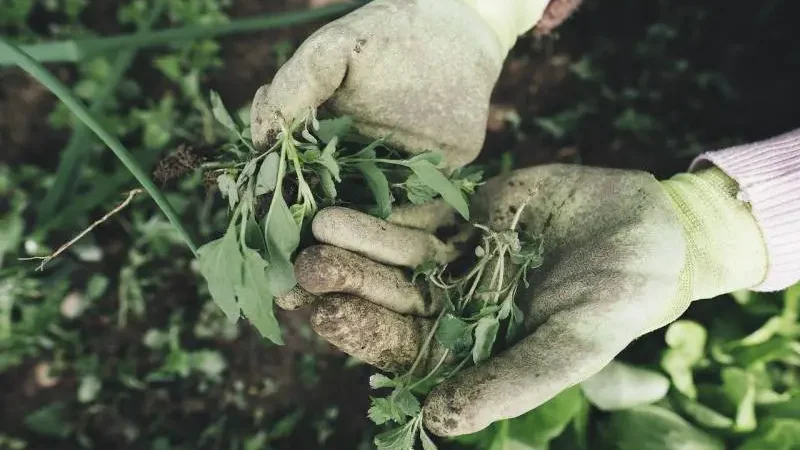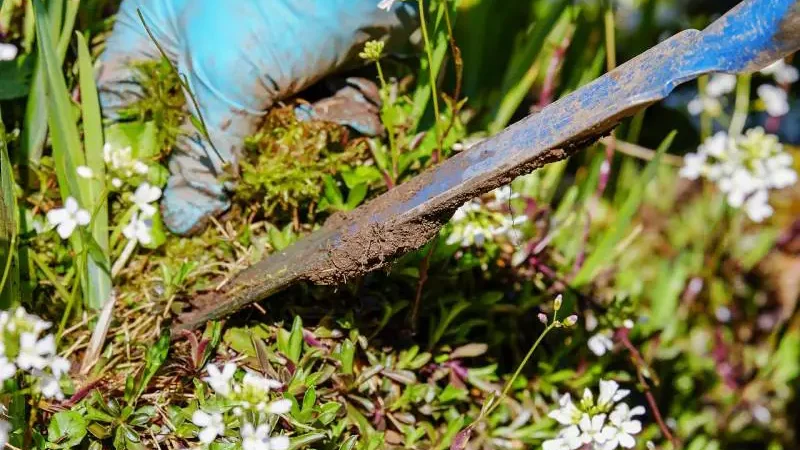3 Safe Ways To Kill Weeds Under Hedge

The absence of weeds makes it a lot easier to nurture and grow healthy green hedging plants. Failure to kill weeds growing under hedges makes the undergrowth compete for light and water with the hedging plants.
Meanwhile, doing nothing to eliminate weed encourages them to grow around and under hedges. The situation is worse when the weeds are growing directly under the hedge. The undergrowth attracts pests and causes a delay in the growth of the hedging plants.
Knowing the right way to kill weeds growing under a hedge is essential. Hence, before you damage your hedging plants along with the unwanted plants, read the safest methods to kill weeds under a hedge:
1. Uproot Weeds Growing Under The Hedge
To eliminate the unwanted plants under the hedge, uproot the grasses and unwanted plants with your hands. It is best to uproot weeds after it has rained because that will make the soil moist and the weeding easier. Also, wear gloves to prevent cuts and blisters on your hand.
Make sure to pull out the weeds with the roots to ensure that they are removed. Leaving roots of the grasses and unwanted plants in the soil gives room for them to reshoot. Gather the non-poisonous grasses for hay and feed them to livestock if you have any. Nevertheless, if there are no livestock to be fed, burn the weeds not to attract pests.
What We Like About This Method
This method effectively removes the unwanted plants from the roots as it opens up a window period for the hedges to grow without the weeds. Addiotionally, since manual weeding does not introduce harmful chemicals into the soil or nearby ecosystems, it can also be a more environmentally friendly option than using chemical herbicides.
However, this method can be time-consuming and is not recommended for weeding done on a large scale.
2. Apply Mulch Around The Base Of The Hedge
Mulch is any material that is laid on the soil surface to shield a plant. They help to keep the soil moist for a long time and prevent unwanted plants from growing around the covered area. Moreover, spreading mulch to the base of the hedging plant will deprive the existing weeds of light and air, thereby killing them.
See Also: How To Make A Mulch Bed?
To protect the hedges, you can apply a thick layer of polyester cloth over the soil surface surrounding the hedging plants. You can also arrange small pieces of stones around them. That will prevent undergrowth.
What We Like About This Method
This method is eco-friendly, cost-effective and does not harm the hedges too. However, the mulch-method does not last very long as the material spread around the base of the hedging plants could decompose or gradually break apart. To make the mulch last for a longer time, add more materials to the ones already in place.
3. Spray With Herbicides
A long-lasting and effective way to kill weeds is to spray the bottom of the hedge with herbicides. However, there are two types of herbicides; selective herbicide and the non-selective herbicide. While the selective herbicide is safe to use in killing unwanted plants under the hedge, non-selective herbicides are not safe at all.
Why? Non-selective herbicides will do an excellent job of killing both the unwanted plant and the hedging plant. Some of the herbicides burn the roots of the unwanted plant and must not touch the base of the hedges. Examples of non-selective herbicides are paraquat, glyphosate, and glufosinate. Some selected herbicides that are safe to use in killing weeds growing under the hedge include:
Kerb Granules
Kerb is a selective herbicide safe to use in killing weeds and grasses growing under the hedge. It works to stop weed seeds from sprouting. Moreover, it not only kills the undergrowth immediately but also provides long-lasting protection against them. Kerb Granules is best applied from late autumn to spring when the temperature is cold and below 80c.
Additionally, Gemstone Granules herbicide is an alternative to Kerb Granules. They both have residual effects. Kerb Granules can control a variety of weeds, including annual grasses, broadleaf weeds, and some sedges.
Falcon
This is another selective herbicide that kills a wide range of weeds as soon as the chemical comes in contact with them. They eradicate weeds that have already broken through the soil. Depending on the product’s formulation, Falcon may or may not be effective against a particular type of weed. Annual grasses, broadleaf weeds, and a few woody plants are a few common weeds that Falcon may be able to control.
In as much as are they safe to kill grasses growing under the hedge, they can also be sprayed over the hedging plants. The herbicide prevents the weeds from going through photosynthesis.
Generally, all plants need photosynthesis to take place so they can convert carbon dioxide into food. When you spray the wanted plants with the Falcon herbicide, their roots, stem, and foliage absorb the chemical. That deprives them of food, and they die afterward.
Flexidor
Flexidor is also a selective herbicide that is safe to kill unwanted plants and broad-leaved weeds growing at the base of hedges. This herbicide has isoxaben as its active ingredient and is best to apply in spring and winter.

Moreover, they have a long-lasting effect and will allow your hedging plants to thrive without competing with unwanted undergrowth. They are best applied using a knapsack or a boom sprayer to spread the chemical on the base of the hedges. To apply using a knapsack, add five to ten milliliters of Flexidor to every ten liters of water, and spray aiming for the undergrowth.
Keep in mind that the effectiveness of a herbicide depends on a number of factors, such as the type of weed, its stage of development, soil type, and environment.
What We Like About This Method
Using the chemical method is the most effective way to kill unwanted plants and grasses on a large scale as it has residual effects. However, always avoid non-selective herbicides when eliminating weeds growing at the bottom of a hedge. For some people’s specific weed control needs, Flexidor might work well, but other people might get better results from other products.
If you’re unsure of which herbicide will work best for your situation, it’s okay to consult with a local farmers market or agricultural specialist.
Conclusion
The method to kill weeds growing under hedges depends on you. If the hedge base is not so bushy, you may decide to uproot instead of using other methods. However, for hedges that have been left unkempt for a very long time, the chemical control method is usually preferred.
Many gardeners like to use mulches to protect hedges because it is safer than using chemicals. Moreover, protecting your hedge with mulch makes the hedgerow more attractive. A smart way to go around it is to apply the non-selective herbicides before mulching for long-lasting protection.